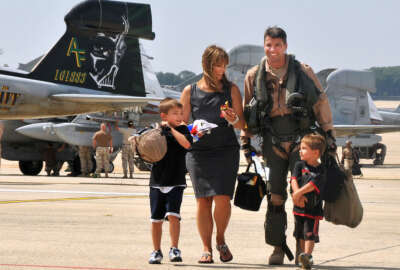
Defense Department raises rates in effort to hire, retain, child care workers
Military families will see an increase in what they pay for childcare as DoD looks to hire and retain more child care staff.
The military may have a hard time recruiting enough soldiers, but it also has a hard time recruiting enough child care workers. With the new 2023 budget in place, the solution is both paying more and charging more. The Department of Defense announced Dec. 23 that families will see an increase in what they pay for their part of child care costs. In a written statement, it cited the need to increase pay to recruit and retain child care workers.
“Most families will see a change in child care fees, but we also know our families understand the importance of ensuring DoD is able to attract the best employees from local labor markets,” said Stacey Young, director of the Office of Military Family Readiness Policy.
Under the current system, families pay about half of the cost of child care, with DoD picking up the other half of the expense at child development centers (CDCs) located on bases. The fees, which are uniform throughout the military, are evaluated annually. Families’ portion of the cost is based on their income.
The difference in the child development program (CDP) fee policy included changing the hourly care rate from $7 to $8 per hour, and increasing the number of income categories from 13 to 14 to determine how much each family pays for child care. The maximum rate military departments will pay for military-certified family child care providers will increase from $1,500 per child, per month to $1,700 per child, per month.
For military families, the increase works out to $8 a month for a total of $569 for full-time child care with a two-week a year vacation option for category five, which is the $61,000 to $71,000 annual income bracket. Category nine, with an income of $102,000 to $112,000, has a monthly rate increase of $678 to $700 for full-time care.
DoD also offers subsidies for approved off-base childcare in a program called Military Child Care in Your Neighborhood-PLUS (MCCYN-PLUS) in areas where military families don’t have access to on-base childcare. The program started in 2019 as a two-year pilot in Maryland and Virginia. It expanded over the past six months from four states to seven states, with DoD planning to keep adding to the program.
Providers in the program have to meet DoD requirements, including licensing and regulation by the state with annual inspections, completing employee background checks and participating in their state’s quality rating and improvement system. It provides a path to military certification for facilities where national accreditation is not available and it is designed to help smaller providers get paid to care for service members’ children.
Outsourcing child care to private facilities is one of the ways DoD wants to address long waitlists to get children enrolled in on-base childcare. In 2020, a Government Accountability Office report concluded that staff shortages and variability in the conditions of facilities at different locations contributed to the waitlists and lack of available child care for service members.
Since the GAO report came out, the DoD has worked to consolidate child care data and target areas where waitlists were the longest. The 2023 National Defense Authorization Act bill also calls for the department to study salaries for child care workers.
The bill said the study should compare “the total compensation, including all pay and benefits, of child care employees of each military child development center in the geographic area to the total compensation of similarly credentialed employees in such geographic area.”
In a September statement, Secretary of Defense Lloyd Austin announced an initiative to improve military childcare. That included allowing CDP caregivers to get a 50% discount or enrolling their own children in the program along with funds to expand infrastructure and facilities for CDCs and increasing operation hours at existing centers. Among other expenditures for child care, the 2023 budget allocated $10 million just to address the waitlist issue.
Money for building and replacing CDCs comes out of the DoD’s Facilities, Sustainment, Restoration and Modernization (FSRM) accounts within the operation and maintenance title. The NDAA calls for funding to match replacement costs of 1% of the total replacement costs of CDCs servicewide be used for construction and renovation of those facilities.
The House Armed Services Committee report on the NDAA said that “The committee is disappointed by the continued chronic underfunding of FSRM over decades and across multiple administrations,” and the committee directed DoD to provide it with a report detailing how much FSRM funding was spent on CDCs over the past five years.
Copyright © 2025 Federal News Network. All rights reserved. This website is not intended for users located within the European Economic Area.
Alexandra Lohr, a former staff member, covered the Defense Department for Federal News Network until September 2023.
Related Stories

NDAA will give direct financial help to servicemembers in need





